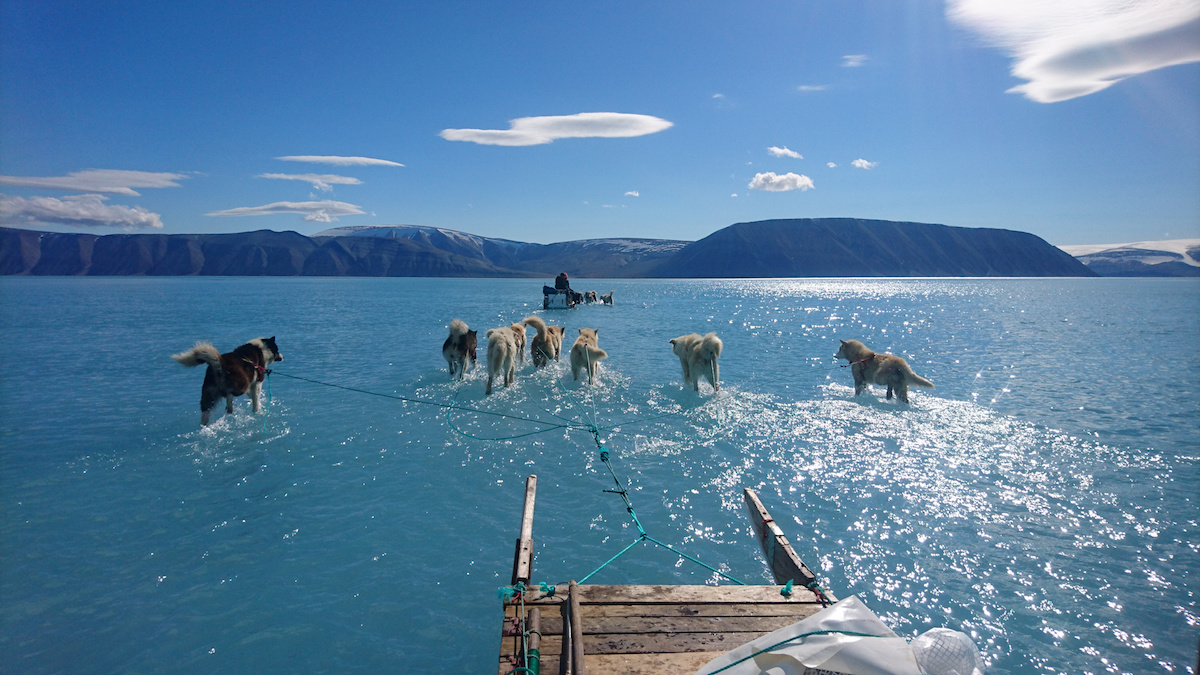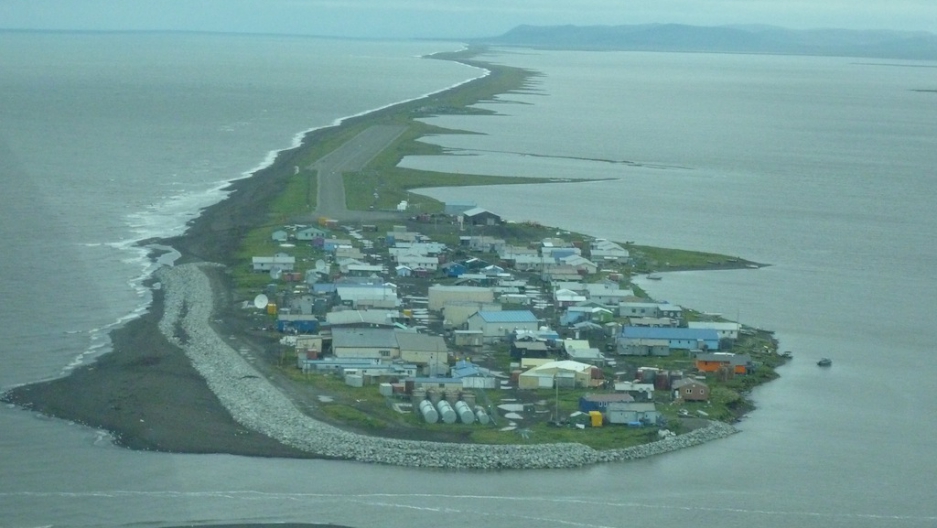From crisis to resilience in the Arctic
We have all the pieces we need to address the effects of global warming in the Arctic, but random acts of adaptation will not be enough.

When Rick Thoman and Brian Brettschneider get alarmed, I freak out. Rick and Brian are climate experts in Alaska, and they know of what they speak. I follow them religiously on Twitter because their reports on temperature anomalies and weather aberrations in the Arctic say more about the pace of global warming than any other source, and they use great graphs and maps. I’ve never met them in person, but I can tell that they’re getting concerned, and they should be.
With every new report about warming trends and winter heat waves, they are adding to a body of knowledge that maps out a dramatic transformation of the Arctic as it warms at two to three times the rate of the rest of the planet. Their maps show deep maroon blotches of abnormal warmth over the Bering and Chukchi seas in February and the shockingly small expanse of winter sea ice as it reaches its seasonal maximum in the dead of winter. In the “lower 48” states, we hear about heat extremes during the summer months, but in the Arctic the most alarming temperature extremes are in the winter — and they are definitely not on the cold end of the thermometer where they should be.
Scientists have known for a long time that the most extreme warming would take place near the poles, where the planet’s climatic fluctuations and variability are most common, but the pace of that warming has outstripped expectations and led to some unexpected developments. In 2014, President Obama’s science advisor, Dr. John Holdren — now a colleague of mine here at the Harvard Belfer Center — described what happens when the temperature differential between the Arctic and mid-latitude regions is reduced. In a widely seen video (below) he explained that reducing that key temperature difference can slow the jet stream into a wavy meander that brings very cold polar air deep into the midlatitudes in winter. It made perfect sense, but he didn’t know just how quickly that phenomenon would become a routine and expected development each winter, as it has now.
The scientific evidence of extreme Arctic warming continues to mount. In 2017, the Arctic Monitoring and Assessment Programme of the Arctic Council, the premier intergovernmental body for the Arctic region, produced a report called Snow, Water, Ice and Permafrost in the Arctic (SWIPA). Full of startling information, it didn’t get a lot of play in mainstream media at the time, but in March 2019 the United Nations Environment Programme produced a wide-ranging report on Arctic trends that re-stated the SWIPA conclusions in rather more stark terms (some of which were erroneous and subsequently corrected). Those two years seemed to make a big difference in public uptake of this information, because this time the media described these conclusions as “devastating.”
And they are.
The SWIPA report explained that no matter how we handle greenhouse gases right now, Paris Agreement or no Paris Agreement, the Arctic is already locked into 4-5° Celsius of winter warming by 2050. In other words, because of the greenhouse gases that we’ve already emitted, most of which linger in the atmosphere for decades, the air over the Arctic ocean will warm precipitously by mid-century, rapidly transforming the region into a new climate state — warmer, wetter and more variable.
The report described what this will look like: Sea-ice-free summers as early as the 2030s will increase warming effects by reducing the reflective capacity of the Arctic. Drastically reduced sea ice extent in winter will restrict ice travel and leave coastal communities exposed to winter storms. A loss of nearly half of the Arctic’s permafrost could release additional amounts of trapped greenhouse gases and will threaten 70 percent of the Arctic’s infrastructure, including homes, roads, airports and pipelines. Coastal and riverine erosion will threaten or displace dozens of coastal and riverside villages. The melting Greenland ice sheet could surpass a tipping point, ramping up global sea level rise and threatening coastal communities and infrastructure worldwide. Arctic ecosystems will transform, and species behavior, composition and range will experience drastic changes at every stage of the food chain, from algae and phytoplankton to carnivores.
These changes will disrupt the subsistence and hunting way of life in the Arctic, where store-bought food is expensive and sometimes scarce, and affect thousands of years of cultural practices and traditions. As the 2017 National Climate Assessment pointed out, the impacts on human health will also be severe, compounding existing vulnerabilities and presenting new challenges for remote communities in Alaska.
Arctic residents and scientists are already seeing these trends play out: So many winter warming records were set in March 2019 that The Washington Post published an article just to chronicle the shocking facts. Every winter month now seems to bring sad news about someone falling through unreliable ice, and the lack of sea ice has drastically curtailed winter hunting opportunities.
Utqiaġvik (Barrow), Alaska average temperature in October of 25.7F (-3.5C) is third highest in the past 99 years. The complete lack of cold Octobers after 2001 tied to collapse of Chukchi Sea autumn sea ice. #akwx #Arctic @Climatologist49 @IARC_Alaska @CinderBDT907 @vennkoenig pic.twitter.com/elHjkgINId
— Rick Thoman (@AlaskaWx) November 1, 2018
But it’s what happens next that really has people like Rick, Brian and Dr. Holdren worried. If society does not rein in emissions quickly to reverse this trend, it is conceivable that winter warming over the Arctic ocean could exceed 9°C by 2100. An April 2019 report from Environment and Climate Change Canada, the Canadian government’s environmental agency, puts that number at 11°C of warming. This is very difficult to comprehend, but suffice it to say that it would be the end of what we know as the Arctic environment, it would transform mid-latitude climate patterns, and it would affect every coastal region on Earth as the northern ice sheets melt away and rapidly raise sea levels worldwide.
However, while we’re relatively locked in for the mid-century effects described above, there is still a chance that, with aggressive global actions to reduce fossil fuel use, we can avoid the catastrophic effects of a 9°C increase by 2100. To do so, civilization must evolve beyond fossil fuels very quickly, and that work must take place at the municipal, state and national levels simultaneously – and with all hands on deck to speed implementation. There is no acceptable alternative to this essential climate mitigation work.
But, at the same time, we must adapt very quickly to the changes that we know are locked in, and in Alaska and the Arctic there is reason for hope. There are some four million people who live in the Arctic, including hundreds of thousands of indigenous people who have been learning the Arctic for thousands of years; there are billions of dollars invested in the region; and some of the planet’s most developed and affluent nations share a direct interest in the Arctic.
We have all the pieces to address the threats; we just need to mobilize. If we set our collective shoulders to the wheel, we can build the necessary resilience to protect health and safety, culture, economies and ecosystems until climate mitigation actions begin to slow the rate of change later this century.
This means we have to innovate and implement adaptation measures with an ambition that matches the scale of this climate threat. We have to acknowledge, honor and elevate indigenous knowledge-holders who, thanks to millennia of practice, may in fact hold the key to unlocking the secrets of resilience in the region. We have to invent and foster innovative ways to finance crafty resilience measures so the North can survive and even thrive through the climate crisis until greenhouse gas reductions provide a reprieve.

But we also have to stop fooling ourselves into thinking that random acts of adaptation are going to do the trick in the face of what we know are going to be dramatic climatic disruptions. International agreements like the Paris Agreement and national actions may be able to slow the rate of change after the middle of the century, but we are not going back to the Arctic climate that characterized human experience for millennia. That Arctic is now a thing of the past, and we are entering a new climate state that no humans have experienced.
Just as business-as-usual in fossil fuel use will bring unspeakable suffering, business-as-usual in Arctic governance will slowly choke off every opportunity to innovate our way through this crisis. Every village, tribe, borough and city has to reinvent its approach to sustainability and resilience, and many of these frontline communities are making good progress on that front.
At the state and federal level, however, change is proving to be more difficult. Every state and federal agency needs to find new ways to get people out of harm’s way, support cultural continuity, ensure food and water security, improve public health and safety, protect essential ecosystems and foster thriving local economies.
The Arctic Council, comprised of the eight Arctic nations and six indigenous organizations, showed remarkable foresight in 2017 when the foreign ministers of the member states approved a resilience framework to guide and foster circumpolar resilience efforts. It was the first regional resilience framework in the world. Now each sub-national and local governance body must find a way to join that community of practice, identify gaps, encourage investment and replicate the successes learned from one another. It’s a perfect opportunity for collaboration and investment and a perfect way to pivot from urgency to agency.
After the 2019 Iditarod sled dog race concluded in Nome, Alaska, a photograph went around the internet showing open, ice-free seawater right up to the beach as one of the finishers crossed the line. Shocking at the time, that image represented a future that is now the present. Change is here, and it’s time to face down these changes and solve the future courageously and ambitiously. The implications are global and foreshadow similar drama worldwide as climate disruptions grow worse. At the Harvard Belfer Center Arctic Initiative, we hope to be on the front lines of change and innovation, learning from and working with Arctic residents and other partners around the world to co-develop the tools, information and resources necessary to address these urgent issues.
Joel Clement is a senior fellow at the Harvard Belfer Center’s Arctic Initiative, a senior fellow with the Union of Concerned Scientists and a former federal executive and a whistleblower.